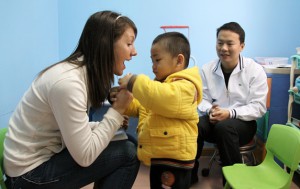
Rachel Reetzke, 2011-2012, China, works with a father and son at the YangAi Parent Club for families of children with developmental disabilities
The impetus for me to begin my Fulbright U.S. Student Program application came during the summer of 2010, as a U.S. Department of State Critical Language Scholar. That summer, I tested my intermediate Mandarin skills by independently organizing a month-long service project at Beijing Stars and Rain Autism Education and Research Center. Through volunteer work at Stars and Rain, I was exposed to a new method of parent training, which provided insight into the diagnosis, and treatment intervention methods for autism spectrum disorders (ASD) in China. Ultimately, the experience revealed to me a dire need for evidence-based practice (EBP) research in the field. I aimed to return to China as a Fulbright student to further explore and develop my place within the networks of doctors, teachers, students, and clinicians serving individuals with ASD in China.
As a Fulbrighter, I became part of an interdisciplinary research team and contributed to the validation of the Chinese Autism Diagnostic Scale (CADS). Currently, there is no autism diagnostic scale based on Chinese linguistic and cultural differences. Therefore, once published, CADS will be a vital tool for current and future diagnosis of ASD in China.
